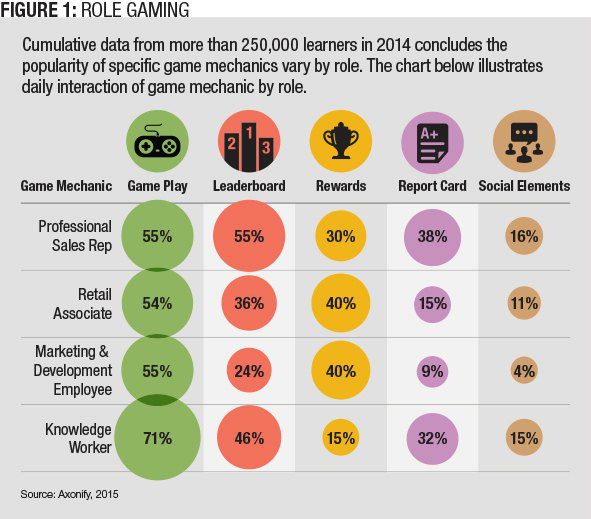
Use a clear story, strategy, scoring system and support to ensure your organization succeeds with game-based learning.
by Sheri Weppel
April 6, 2015
The world is full of distractions.
It’s difficult to have a conversation without various devices pinging and beeping, calling attention away from the task at hand. This is particularly challenging when it comes time for employees to participate in mandatory learning and development activities. Many times learners are more interested in the distractions than in the knowledge they’re supposed to acquire.
In using game-based learning, organizations can harness the power of these distractions to their advantage, rather than competing with them. A challenge; scoring; richly drawn, relatable characters; and competitive timing are just a few attributes of gaming that can easily be incorporated into a training activity. By making things more exciting, development offerings transform from a requirement to an integral, even desirable part of the job experience.
However, gaming is a new method of instruction for many in the corporate world, and that can make them a tough sell. The mere mention of game-based learning can evoke feelings of distrust and disbelief in more traditionally inclined stakeholders or senior management because they may associate gaming with childlike behavior.
There is a middle ground that can meet both learners’ desires and organizational expectations, but not everyone sees it. All too often, organizations dismiss gaming in favor of more traditional learning approaches. If we take a closer look at the elements like story, score, strategy and support, it is possible to harness gaming’s power and maintain expectations of professionalism in a learning program (Figure 1).

Consider the games many of us played during childhood. The same four key elements captured and maintained our attention: story, strategy, score and support. The success of game-based learning does not depend on the technical aspects of a solution, but on the design and thought that goes into the game development.
Can You Tell Me a Story?
A great game begins with a story. Whether rescuing a princess, solving a crime or simply trying to capture the flag, a game is wrapped around a theme or an idea. There is a story behind most learning needs, too, but learning solutions tend to focus on straightforward facts. Storytelling helps the learner connect to the content and become engaged in the experience.
So, what is the story? What key message should learners walk away with? This message should be the focus of the learning solution. It should be clear why this training is important to the business or critical for a particular role and how the information in the game can be used on the job.
For instance, safety training for a manufacturing company could be a simple page-turner alerting the learner to the hazards of forklifts in an industrial environment. But using one of the four gaming elements — story — that traditional training offerings morph into a scenario where the learner becomes a pedestrian who can determine when it’s safe to cross a pathway. The learner might have a number of lives, a number of paths to cross and a time limit to be immersed in the learning environment. This module gets the learner engrained in the story — rather than starting the module with the usual “In this module, you will learn.” Adding a story or context to information can capture the learner’s attention. It also can help to guide the learning and increase the learners’ ability to absorb and retain the desired knowledge.
What Strategy Should We Use?
The second element of a good game is to maintain the learner’s attention throughout the experience. Create a strategy or challenge for the learner to complete while engaged in training. The strategy should answer three questions: What will the learner do? Is this applicable to their job? And what is the possibility of success?
For instance in GE’s onboarding game, as the learners complete the different training sections, they will collect keys to a make-believe kingdom. While learners are searching for the keys, they willexplore different areas of the business, learning lessons and absorbing information at each stage of the journey. This strategy provides them with an ultimate goal, motivating the learner to continue through the module using intermittent successes to increase learner satisfaction along the way.
GE Healthcare Plays to Win
GE Healthcare successfully employed game-based learning for new hire onboarding. In January, the company delivered the “Know Your Business Challenge” game. GE Healthcare opted to host a virtual, synchronous challenge so learners could compete to answer questions and win bragging rights.
“Gaming not only keeps the learners involved and interacting, it allows us to deliver information in a way that makes it memorable, which is the whole point,” said Beth Schaul, GE Healthcare’s director of commercial learning and development for the U.S. and Canada.
— Madelyn Mlinar and Sheri Weppel
The challenge should be directly related to the learner’s job, but it can be conveyed in an abstract manner. For example, the keys in the GE Healthcare onboarding game are not only a part of the story, but also they’re a way to impart to the learner that a keen understanding of the business will be the key to their success. However, unlike traditional video games, the learner should have a good chance of success. Otherwise, frustration will override any innovativeefforts used to keep the learner engaged. An effective strategy can encourage the learner to complete the training, while motivating the learner through the learning experience.
Did I Win?
The next element is score. With game-based learning, there may not be formal objectives or knowledge checks along the way. When it comes to assessing the learner, it’s vital to consider what is truly important. The learner should be able to glean answers to three questions from the game: Does a percentage matter, does time matter, and is status more important?
An assessment doesn’t have to be a number or a percentage; it could be points earned for visiting locations or clicking on items within a certain timeframe. Or it could be something as simple as a red, yellow and green status indicating progress.
It is important to consider what really needs to be assessed, and whether a formal assessment is truly needed for training to be considered successful. Consider adding mini assessments, or mini games, to provide intermediary scores to continue to motivate the learner. The final consideration relative to score is tracking. Be thoughtful about what training components such as time on task or pass/fail are recorded in the learning management system. Some training solutions need to be tracked, but other assessments can be used to provide learners with feedback on their progress and retention of the material.
What If I Need Support?
The last important gaming element is support. When traditional organizational training styles shift, learners need to be prepared for that change. They may not be familiar with game-based learning or gaming elements. Therefore, it is important to include support mechanisms to help the learner transition from a more didactic instruction to a more exploratory approach. The game should answer three questions: When will tools be needed? What kinds of help are needed? And does the learner know what to do?
In the beginning, that may require adding more instructions, guided cues and other tools to support the learner within a module. While this may feel as if it makes the module less challenging or more restrictive, learning leaders should remember that it’s their responsibility to ensure knowledge transfer occurs. In time, support tools may only need to be made available on an ad hoc basis, but until an organization fully acclimates learners to a game-based delivery approach, learners need to be able to easily access support and directions on how to succeed. This support helps maintain the learner’s attention and encourages them to complete the training.

As organizations make room for innovative learning delivery approaches, employee preferences are often dismissed. Support is needed not only to accommodate different learning styles such as providing close captioning for non-auditory learners but to also align with employees’ different learning preferences. For instance, ensure audio is included in a game via sound effects and narration to appeal to auditory learners.
It’s also important to consider that not everyone enjoys gaming. For example, in a multigenerational workplace, it may be necessary to provide an “opt-out” component. This would allow learners who are not interested in games to receive the same content in an alternate fashion. The more flexible a module is, with the necessary support, the more successful it will be for the entire organization.
A thorough audience analysis should be conducted internally to determine appropriate delivery methods for learning offerings, considering all aspects of the population including: mobile requirements, audio requirements, gaming preferences and bandwidth constraints. A keen understanding of the audience also will help to ensure a learning solution is deployed successfully.
While gaming is still a novel approach in the learning and development industry, when designed with the four key elements — story, strategy, score and support — it can be a viable and impactful approach to breathe new life into required training. Game-based learning can harness the everyday distractions that usually hinder the focus necessary for knowledge transfer. The end result is a learner who is engaged and may actually enjoy required training.



